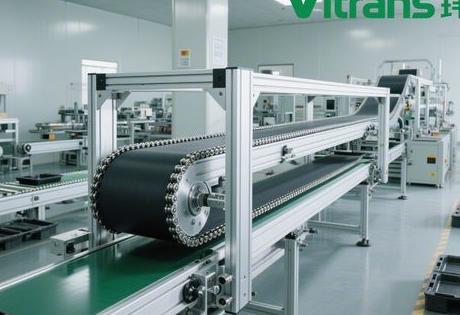Accumulation drum line choose wrong model? 3 parameters accurate matching save 30% cost
As the core component of the logistics automation system, the selection of Ljxy accumulation roller conveyor line directly determines the production line efficiency and long-term operation and maintenance costs. Combined with the practical experience of automotive manufacturing, e-commerce sorting and other scenes, this article will dismantle the core parameters of the selection and quotation strategy to help novices avoid the selection of 90% misunderstandings.

I. Core Parameter Calculation: Accurate Matching from Load to Layout
1. Golden formula for load capacity and drum size
- Calculation of single drum load: Total weight of goods ÷ number of contact rollers (≥3), e.g. 800kg pallet should be supported by at least 4 rollers, single load ≤200kg.
- Diameter Adaptation Rules::
- Light load (≤200kg): φ50mm galvanised steel roller
- Heavy load (>500kg): φ76mm hardened alloy steel drum (compressive strength increased by 40%)
- Wall thickness and shaft diameter: Heavy-duty scenario shaft diameter ≥φ25mm, wall thickness >3mm (anti-bending deformation)
2. Layout design is a matter of life and death
- Horizontal segment spacing: ≤ 1/3 of the length of the goods (e.g. 1.2m pallet spacing ≤ 400mm)
- Turning section design::
- Radius ≥ 1.5 times the line width (600mm wide conveyor line needs ≥ 900mm turning radius)
- Conical drum taper 2.4°~3.6° (reduce material deflection)
- multilayer layout: Difference in height between floors ≥800mm (reserved access for maintenance)
3. Cost-performance options for drive configurations

| take | Driver Type | cost range | Adaptation Case |
|---|---|---|---|
| Clean room (food/pharmaceutical) | O-Belt Drive | ¥350-550/m | Filling line silent conveying (<60dB) |
| Heavy Duty Assembly Line | Double sprocket drive | ¥780-1200/m | Car chassis transport (load > 1 tonne) |
| Dynamic Beat Adjustment | Variable frequency motors | Base Price + ¥2000 | E-commerce sorting line (speed 5-15m/min) |
Second, manufacturers offer demystification: standard products vs. customised cost components
1. Standard configuration cost range
- Lightweight Linear Body(Width 300-600mm): ¥288-650/m (made of carbon steel + sprocket drive)
- Heavy Duty Accumulation Line(Width 800-1200mm): ¥900-1500/m (with bevel gear drive + positioning module)
Quotation example: TS7-BG1-B500-L4000 (double track / width 500mm / length 4 metres) tax included price of about ¥ 5200
2. Customised list of incremental costs
- Material upgrade: Stainless steel 316L is more expensive than carbon steel 40% (a must for corrosion-resistant scenarios)
- Special Function Modules::
- Ejector positioning unit: +¥3200/station (repeatability ±0.3mm)
- 90° rotary table: +¥5800/set (servo-driven / 4 seconds to complete steering)
- Explosion-proof certification: Chemical scenario cost escalation 25% (Ex d IIC T4 standard)
Third, the selection process to avoid the pit: the novice must see the 3 major minefields
Minefield 1: Ignore the characteristics of the material's underside

- error case: Standard rollers for soft packaged goods → jamming and wear (monthly failure rate >15%)
- prescription: Belt/chain plate composite structure for irregular bottom surface (anti-jamming of conveyor belt bottom)
Minefield 2: Inadequate configuration of accumulation and release functions
- fatal consequence: Assembly line blockage leading to downtime (loss per hour > ¥ 8000)
- Key parameters: Friction plate pressure 0.5~3N/mm² (to be dynamically adjusted according to pallet weight)
Minefield 3: Maintenance costs not accounted for
- Comparison of hidden expenditures::
- Conventional chain drive: lubrication every 500 hours (annual maintenance ¥6000+)
- Bevel gear drive: lubrication-free design (maintenance costs reduced by 50%)
IV. Special scenarios tailored solutions: high-temperature/corrosive environment solutions
High temperature workshop (>200°C)::
- Roller material: hardened alloy steel + temperature-resistant bearings (limit heat-resistant 300 ℃)
- Lubrication strategy: silicone-based grease instead of mineral grease (replenishment intervals reduced to 300 hours)
Corrosive environments (chemical/plating)::
- Surface treatment: Galvanised layer >80μm (salt spray test >720 hours)
- Structural optimisation: fully enclosed rack + drainage holes (zero residue of acid and alkali liquids)
V. Vendor co-operation practical advice: this negotiation to save 15% costs
- Modular Sourcing Strategy: First base line body + reserved connection (later increase shunt to save secondary installation fee)
- Acceptance Criteria Lock: Dynamic load test ≥ 1.2 times the design value (to avoid the hidden danger of no-load compliance)
- Maintenance Agreement Highlights::
- Quick release structure commitment (drum replacement ≤ 10 minutes)
- Response timescale clause (4 hours to site for faults)
Industry insight: 2025 customisation cycle for head manufacturers has shrunk to 7 days (Wei Chuang and other companies pre-assembled module inventory accounted for >60%), seizing quarterly promotional nodes can reduce the cost of another 8%
Ultimate selection mnemonic: first calculate the load and then measure the site, drive according to the scene to choose, the material depends on the environment to determine.When you negotiate with a precise list of parameters, the manufacturer's salesman's "recommended add-ons" will be completely ineffective - after all, the data is the nuclear weapon of cost control.













